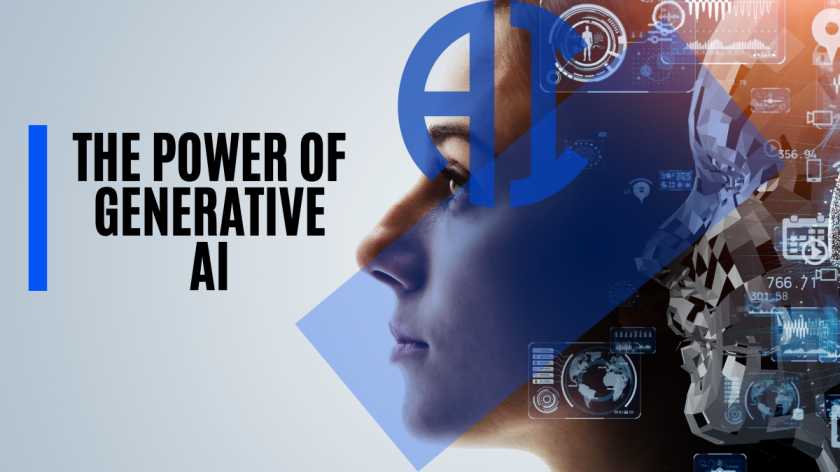Table of Contents
Last updated on July 25th, 2024 at 10:57 am
As generative AI takes over, a tidal wave of innovation is set to hit all sectors. It will help create ground-breaking marketing campaigns, design new products, and develop code ideas—all in one go! That is the power that generative AI applications put in your hands.
This blog explores the numerous ways generative AI is being used in the real world. We explore areas of marketing, design, science, and manufacturing.
Definition of Generative AI
Generative AI, short for generative artificial intelligence, is a type of AI that can create new data —text, images, music, or code. It works by learning the patterns and relationships within a massive dataset of existing content.
It is similar to having a giant library with books on every topic. Generative AI applications read all these, learn the rules of grammar, sentence structure, and storytelling, and then use that knowledge to write their own stories.
Here’s how it works:
- Training: Generative AI models are trained on massive datasets. This could be millions of images, lines of code, or pieces of music.
- Pattern recognition: As the model is trained, it recognises patterns and relationships within the data. It learns to recognise the elements that make up a cat picture, a pop song, or a computer program.
- Content creation: Once trained, the model can use that knowledge to generate new content. It can create realistic images of cats that have never existed, compose music in a specific genre, or write code for a new software program.
After all, what is generative AI if it isn’t about diversification?
Examples of Generative AI
Generative AI is an emerging field with many applications. We’re already seeing it used in:
- Marketing: New ad copy, product descriptions, and social media content.
- Art and design: New design ideas, unique visual content, and music.
- Science and engineering: Drug discovery, materials science, and new product development.
Here are some examples of generative AI applications by area of expertise:
-
Text Generation
- Jasper: Marketing copy, blog posts, website content, and scripts.
- Writesonic: Product descriptions, social media posts, and email marketing campaigns.
- Scribe: Academic and professional writing, research, summarising articles and reports.
Image Generation
- DALL-E 2: OpenAI’s tool that turns text descriptions into photorealistic images.
- Midjourney: Image generation platform for creative and artistic outputs.
- NightCafe Creator: Digital artwork based on user prompts and artistic styles.
Code Generation
- Github Copilot: AI assistant for programmers that suggests code completions and functions based on context.
- Tabnine: Code completion tool that learns from your coding style.
- DeepCode: Code quality improvement.
In terms of miscellaneous activities, here’s more of what generative AI applications can perform:
- Murf.ai: Voiceovers in many styles and languages.
- Amper Music: Music to your preferences and mood.
- Synthesia: Videos from text inputs. AI presenters.
Generative AI Applications
Generative AI deals with multitudes of industries. Its applications are known to have worked within these industries successfully:
Marketing and Advertising
Marketing has gotten even more creative with generative AI applications. Here’s how generative AI is making marketing effective:
- Personalised messages for everyone: What is generative AI but a haven for human interaction? No more one-size-fits-all marketing! Generative AI can create content, like ad copy and social media posts, that talks directly to each person’s interests. Not just that, a recent report even showed how over 44% of marketers use GenAI solely for email copy while others depend on it for social media copies.
- Visuals in a flash: Creating great images and videos is a pain. Generative AI can create unique visuals for your brand and campaign in seconds, saving you time and money. Access fresh content, constantly, without the hassle.
- Testing made easy: Finding the perfect marketing message is similar to finding a needle in a haystack. Generative AI can create multiple versions of ads and headlines, and you can test them all quickly to see what works best. It’s like having a million test audiences at your fingertips!
- Targeting like a professional: The definition of Generative AI extends to analysing tons of data to know what people want. You can precisely target your ads, making them reach the right people with the right message at the right time. To learn more, opt for generative AI courses like the Advanced Certificate Programme in Generative AI by Imarticus.
Here are a few popular examples of where we can experience Gen AI:
- Netflix: A movie trailer made just for you, highlighting the bits you’ll love most. That’s what Netflix does with generative AI, and it keeps people hooked.
- Uber: Ever get an Uber email with a special offer just for you? Generative AI applications like this use your past rides to suggest deals that make sense and keep you seeking more.
- BBC: The BBC uses generative AI applications to create personalised social media posts based on your viewing habits so you discover various content.
Software Development
The definition of Generative AI is incomplete without the mention of software development. This technology allows you to write repetitive code snippets.
Moreover, you can use it for suggestions to solve problems and even instruct it to catch bugs before they sabotage your code. Moreover, 91% of Deloitte professionals believe in the power of Generative AI applications to improve organisational productivity.
Let’s look at some examples:
- Github Copilot: This popular tool is like an AI assistant regarding generative AI applications. It suggests code completions and functions as you type.
- Tabnine: Another code completion tool, Tabnine learns your coding style and preferences over time and gives you suggestions based on how you work.
- DeepCode: This AI tool goes beyond just writing code. It analyses your codebase to find potential bugs and security vulnerabilities so you can write cleaner and more secure software.
Financial services
Generative AI applications create entirely new data and are moving quickly across industries. Below are a few ways generative AI is disrupting industries:
- JPMorgan Chase: Experiment with generative AI to analyse data and find trading opportunities.
- HSBC: Use generative AI to create synthetic data for fraud detection models.
- BlackRock: Explore generative AI for portfolio optimisation, building more diverse investment strategies.
Enterprises
Generative AI can automate the mundane —data entry, report generation, and even basic coding. It frees employees to do what they do best: innovate, strategise, and crush those quarterly targets.
Here’s how generative AI applications aid enterprises:
- Personalised customer interaction: Create unique content, targeted marketing materials, and chatbots that truly connect with customers.
- Work smarter: Brainstorm new product ideas, generate design variations, and write basic code for prototypes —all with AI as your partner.
- Data-driven decisions: Analyse massive datasets and find hidden insights to make better business decisions.
- Streamline operations: Less time on admin tasks means more money saved.
- Alleviate marketing and sales: Personalised content creation means higher conversion rates and a stronger brand.
- R&D to the rescue: Bring innovative ideas to market faster.
- Become a risk management expert: Identify and mitigate financial risks before they strike.
Generative Adversarial Networks (GANs)
Two AI systems are in an artistic battle. One is the generator, trying to create more realistic paintings, and the other is the discriminator, trying to separate the real from the fake. This is the basic idea of Generative Adversarial Networks (GANs), a deep learning technique that explores the limits of artificial creativity. This is where generative AI applications find their extension.
How GANs Work
Here’s an example to get you started: A forger is creating very convincing counterfeits while a detective is trying to catch the forgeries. The forger improves their technique based on the detective’s feedback, and the loop continues.
In a GAN:
- The generator: Creates new data, like images, text, or music, from random noise.
- The discriminator: Analyses the generated data and tries to determine if it’s real or fake based on its training on real data.
Through this ongoing competition, the generator learns to create increasingly realistic outputs, while the discriminator becomes a sharper critic.

Generative AI Applications Using GANs
Generative AI courses often cover GANs, an integral part of GenAI. GANs are no longer confined to research labs. Instead, you can find them in these areas:
-
Art and Design
GANs can create incredibly realistic images in any style. With Generative AI applications, you can generate new fashion designs that capture the essence of a particular era or designer or compose music that seamlessly blends different genres. GANs can even create photorealistic portraits from text descriptions, opening up new possibilities for personalised art.
-
Marketing and Advertising
Personalise marketing campaigns by generating targeted visuals or crafting product descriptions for specific demographics. For instance, generative AI applications let GANs create custom social media posts for a user’s interests or generate product mockups. GANs can also generate different ad variations for A/B testing so marketers can optimise their campaigns for maximum impact.
-
Drug Discovery and Materials Science
Simulate complex molecules or materials to speed up research and development. GANs can analyse huge datasets of existing molecules and materials and then use that knowledge to generate entirely new ones with specific properties.
This can lead to breakthroughs in areas like medicine, where GANs can design new drugs with fewer side effects, or in materials science, where GANs can create new materials with better strength, conductivity, or other desirable properties.
-
Fashion and E-commerce
Create personalised clothing recommendations based on a user’s style or browsing history. Imagine a virtual stylist powered by GANs who can suggest new outfits that match your current wardrobe or create a look for a special occasion.
GANs can also create product images for online stores, eliminating the need for expensive photo shoots and allowing for more product views to be shown.
Summary
Generative AI applications are modifying industries, from automating tasks in companies to creating new art forms with GANs. As this tech matures, the demand for skilled people will skyrocket.
This is the right time to register for generative AI courses. An Advanced Certificate Programme in Generative AI will give you the knowledge and skills to lead in this space, learn from industry experts, develop practical skills, and move your career forward.
Don’t miss out – sign up now and command generative AI!
FAQs
- What is generative AI?
The definition of Generative AI extends to a type of AI that can create entirely new data, such as text, images, music, or even code from inputs in the same format. All you have to do is give it instructions according to the modality of the system.
- What is the difference between AI and generative AI?
AI is great at data analysis, the foundation for tasks like recommendation systems or fraud detection. Generative AI applications let a specialised type of AI go a step further. It can analyse data and use that knowledge to create new content, like realistic images or new product designs.
- How to use GenAI?
Using GenAI is as simple as it gets. Describe what you want (text, image, code), and feed it data. You will have your AI output in no time.
- What are GenAI examples?
Generative AI applications are widespread in terms of text generation (like AI-written articles), image synthesis (creating images from descriptions), and music composition (generating songs on varied styles).

